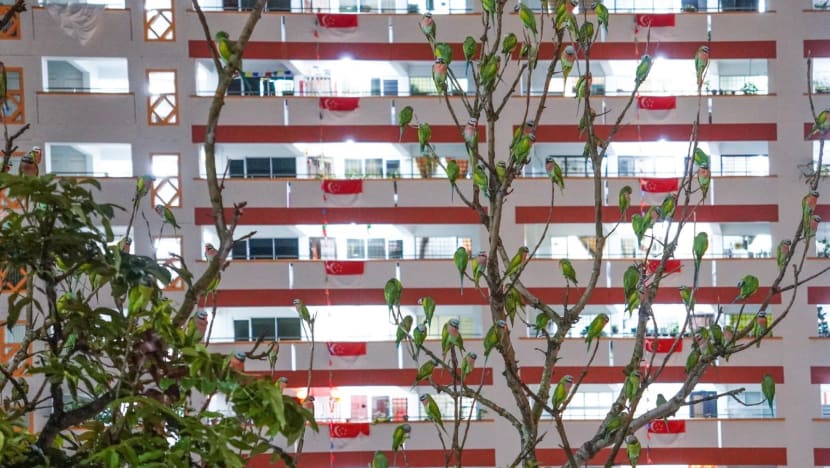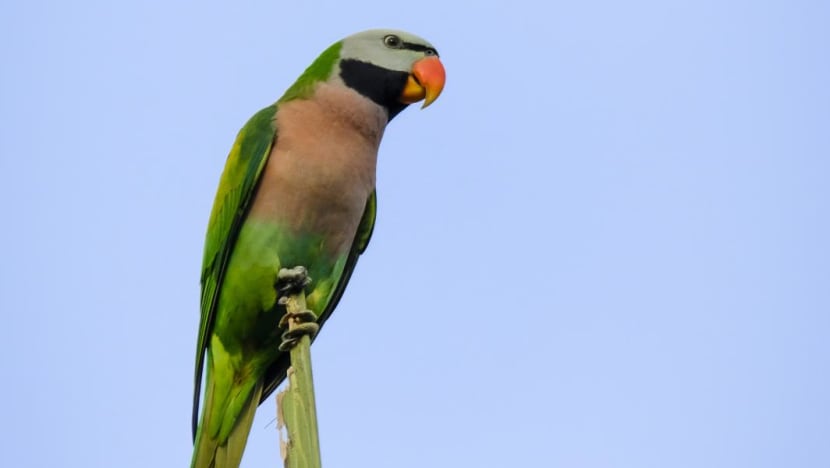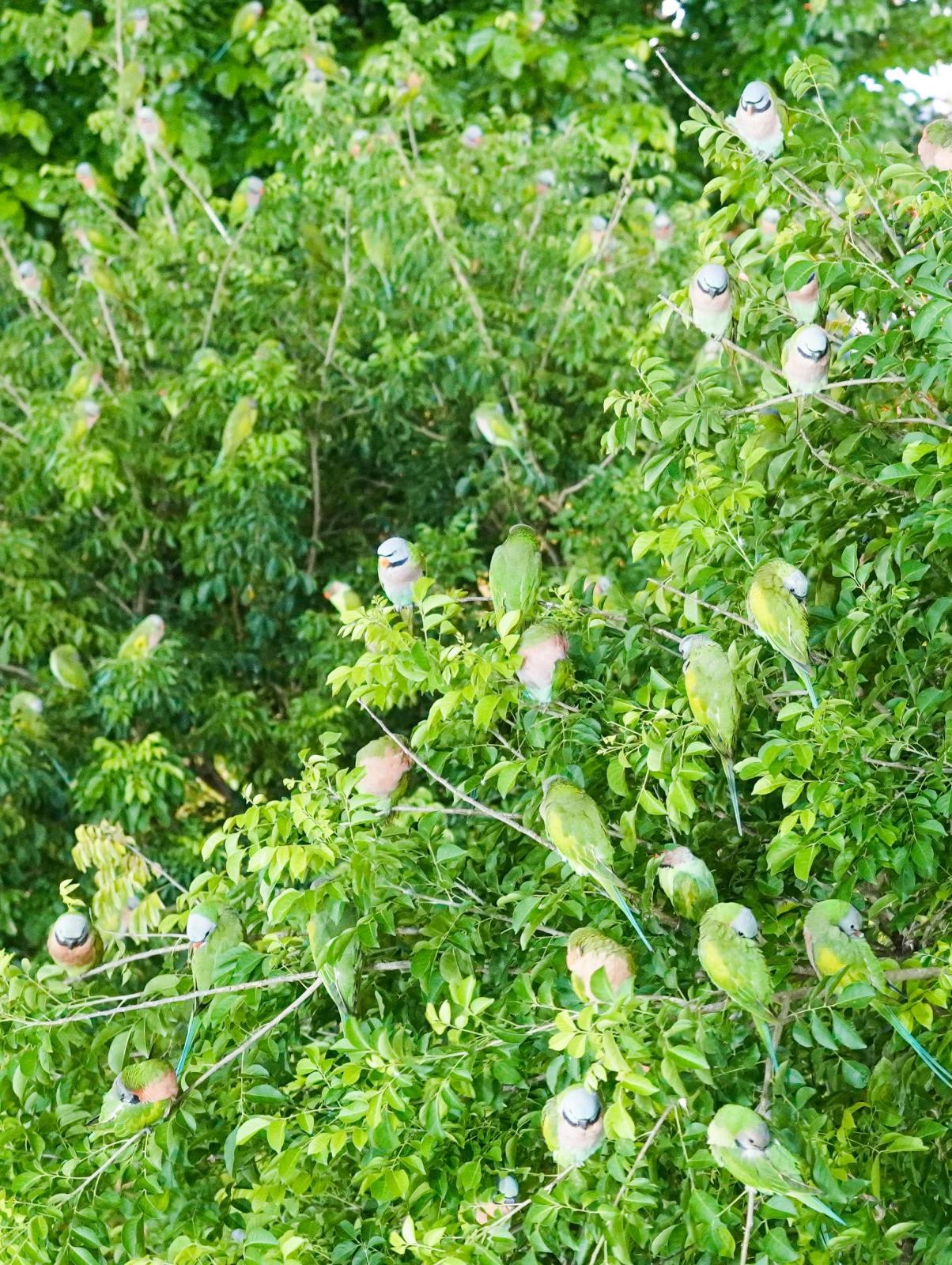Not leaves but birds: Parakeets occupy trees in Choa Chu Kang as population grows
The number of red-breasted parakeets in Singapore has been increasing steadily, and their roosting spots in Choa Chu Kang and Clementi are well-known to bird watchers.

A flock of red-breasted parakeets on trees in Choa Chu Kang on Jul 10, 2023. (Photo: James Teiw)
SINGAPORE: Most evenings, an unusual sight greets Choa Chu Kang residents.
In place of leaves, more than 70 green birds perch on a tree's bare branches, resembling red-green mangoes.
These birds are red-breasted parakeets, or moustached parakeets, a species introduced to Singapore in 1940s as pets, according to the National Parks Board (NParks).
But the parakeets were either released or escaped into the wild, where their numbers have been flourishing, experts told CNA.

Known for their green plumage and distinctive pink or reddish breasts, the birds, which feed on fruits and seeds and breed in tree cavities, can be found in parks, gardens and scrubland across Singapore. They are also often seen in large flocks in urban areas like Clementi and Choa Chu Kang.
Retiree James Teiw, who photographed a company of parakeets on a tree last Monday (Jul 10) around 8pm, posted the picture on Facebook group Singapore Wildlife Sightings where it has received more than 8,000 reactions.
Mr Teiw, 60, told CNA that he enjoys taking walks in the evening in hopes of seeing the birds.
"I live in Choa Chu Kang, which is near the gathering point of birds at dusk, so I often have the opportunity to meet them. Photography or videography is my hobby, so after dinner I like to go for a walk where the birds often appear."
Mr Teiw has since posted several more photos of the red-breasted parakeets and a short video of the birds amassing on tree branches.
"They like to hover in the sky for a few minutes, and then they will stop on the nearby trees. Some will sleep in the trees, others stay for a while before flying off," he said.
The number of red-breasted parakeets in Singapore has been increasing steadily over the last two decades, according to the Nature Society (Singapore) (NSS) bird group, which keeps track of the figures.
The roosting spots in Clementi and Choa Chu Kang are well known to the group, which initiated an annual count in 2011 to document the number of introduced and native parrots in Singapore's urban areas.
The group's parrot count the following year found that while the red-breasted parakeet was uncommon in Singapore in the decade before, its numbers had overtaken the native long-tailed parakeet.
At least 329 red-breasted parakeets were counted that year, accounting for 64.5 per cent of all parrots recorded.
This year, volunteers counted about 700 red-breasted parakeets in Choa Chu Kang, 91 in Clementi and 14 in Yishun, said NSS' parrot count coordinator Yong Ding Li, who co-authored the 2012 report.
Apart from the red-breasted parakeet, Singapore has two other regularly encountered species of parakeets: the native long-tailed parakeet and the rose-ringed parakeet, another invasive species. Both are green and look similar in appearance to red-breasted parakeets.
Large flocks of green birds seen in urban areas tend to be mostly red-breasted parakeets and a smaller proportion of long-tailed parakeets. However the two species do not mix, experts said.
Noting how the population of red-breasted parakeets here has doubled in the past decade, chairman of NSS' bird group Tan Gim Cheong suggested Singapore's climate as a reason for their proliferation.
Red-breasted parakeets are native to Thailand and the Indochina region which have a similar climate to Singapore.
"Since the environment is suitable, it can adapt to the urban environment. It will nest on tree holes that are close to our housing estates and they even compete with bigger parrots (like cockatoos)," Mr Tan said.

LARGE FLOCKS IN HOUSING ESTATES
On why they roost in specific areas in the west of Singapore, Dr Yong suggested that it was because of the proximity to forested areas.
"The birds are able to thrive in secondary woodlands in Singapore, like those you see in the Rail Corridor, Tengah, Kranji and Lentor. They can find food and nesting resources in these areas. And these woodlands are not so different from their open forest habitat in Cambodia or Thailand."
Their large numbers have posed problems in Choa Chu Kang, where the town council and NParks caught and culled some birds in November last year, as reported by the Straits Times.
In response to CNA's queries, NParks said it received 79 cases of feedback on parakeets between 2020 and 2022. About half of these were sightings and reports of animals requiring rescue.
As with invasive species, a hike in the number of red-breasted parakeets has implications for the ecosystem.
"Being a non-native species, the red-breasted parakeets may negatively impact native biodiversity when present in large numbers, by competing with our native bird species for food and nesting sites," said NParks' group director of wildlife management Ryan Lee.
"They may also indirectly affect native biodiversity through the transmission of exotic diseases and parasites."
Dr Yong agreed, saying that red-breasted parakeets compete with local species such as hill mynas, long-tailed parakeets, hornbills and common goldenback woodpeckers for tree cavities to nest.
"There's heavy competition for the nest holes. So many birds need the nest holes but so few bird species build (them)."
Dr Yong cautioned about another non-native parakeet species that appeared to be an "emerging problem". The monk parakeet, also green in colour, has colonies in Pasir Ris and Changi and is a highly invasive species, he said.
While non-native parakeets may be a threat to local birds, they do not enter human premises to scavenge for food.
"So from a human disturbance point of view ... it is not as major an issue as crows and mynas, but from an ecological point of view there are real and tangible problems," said Dr Yong.
"The (red-breasted) parakeets have reached a level of population that they can never be eradicated. They are established in the Singaporean ecosystem permanently and have spread to nearby areas of Malaysia."
NParks cautioned the public against releasing animals or pets into the wild. It also said that releasing an animal into a nature reserve or a waterway that flows into or through a nature reserve is an offence.
















